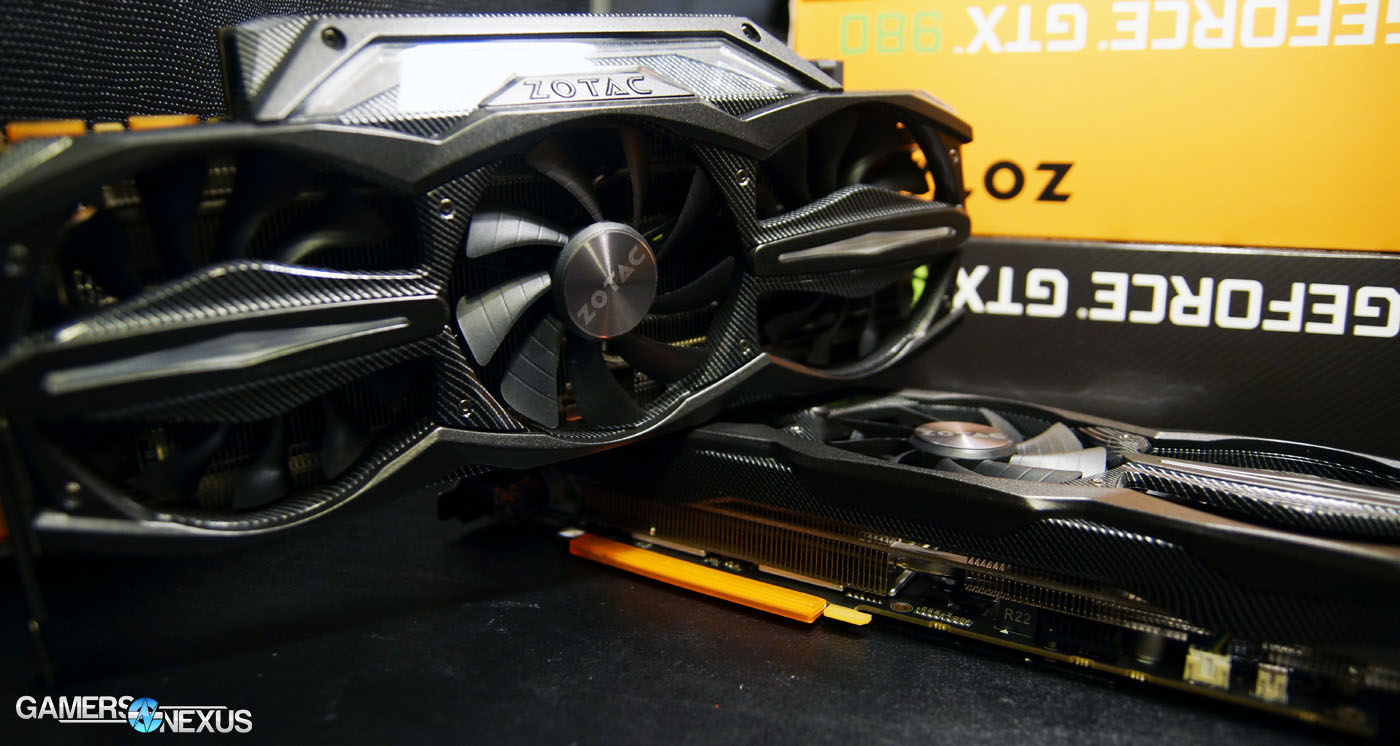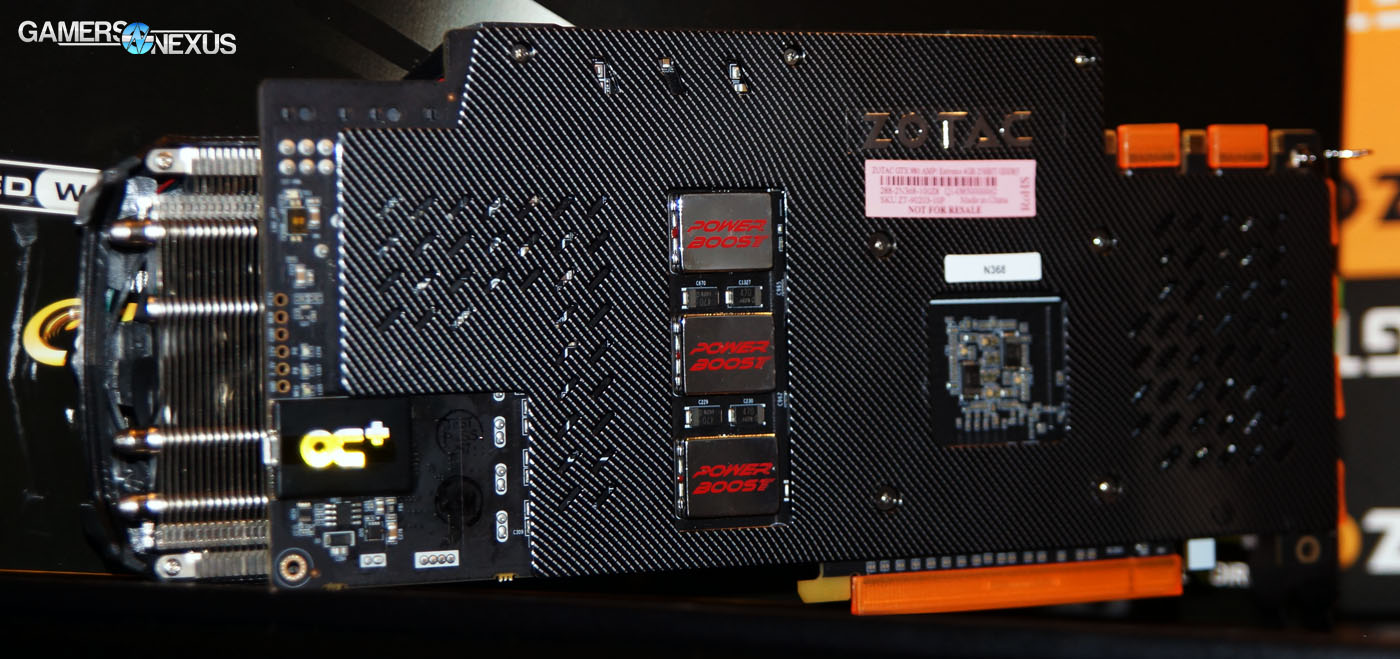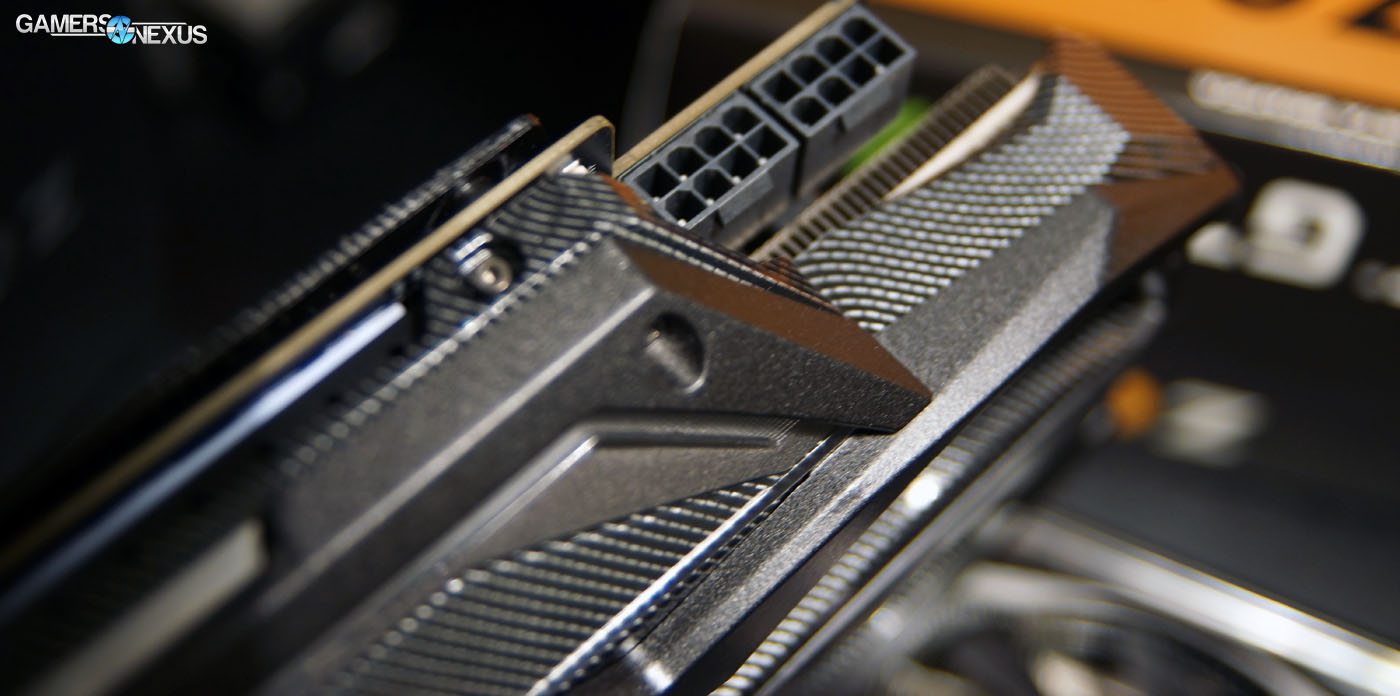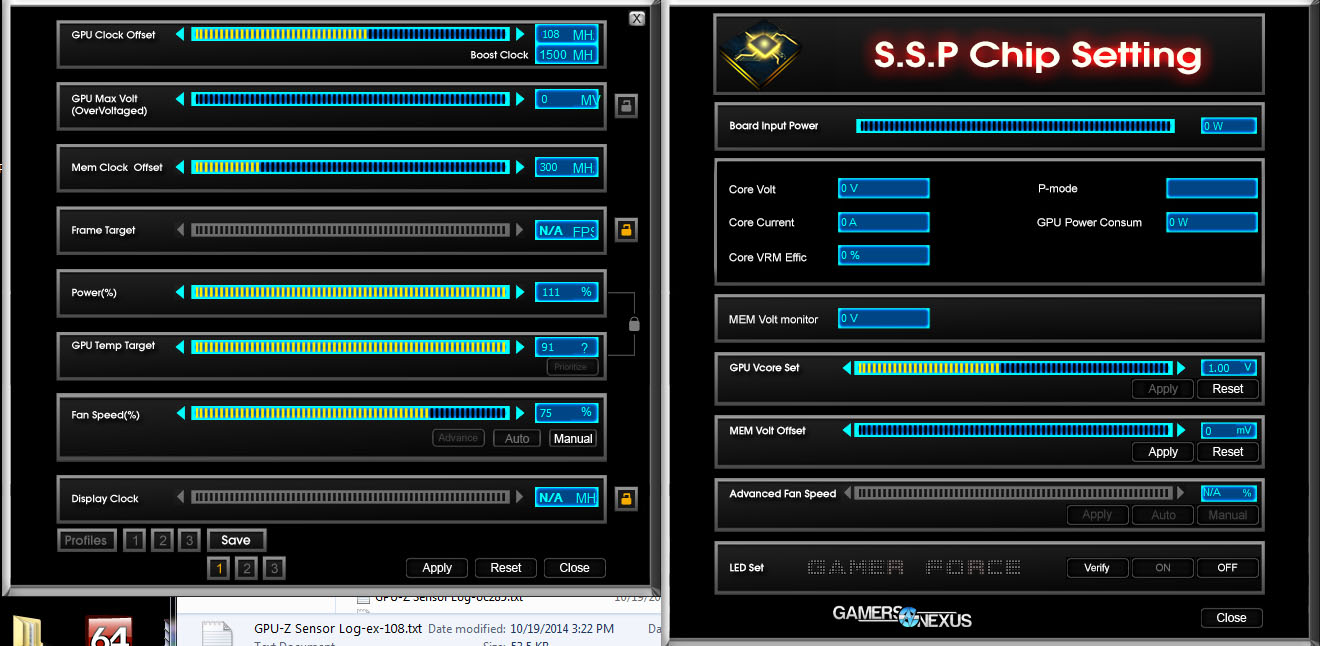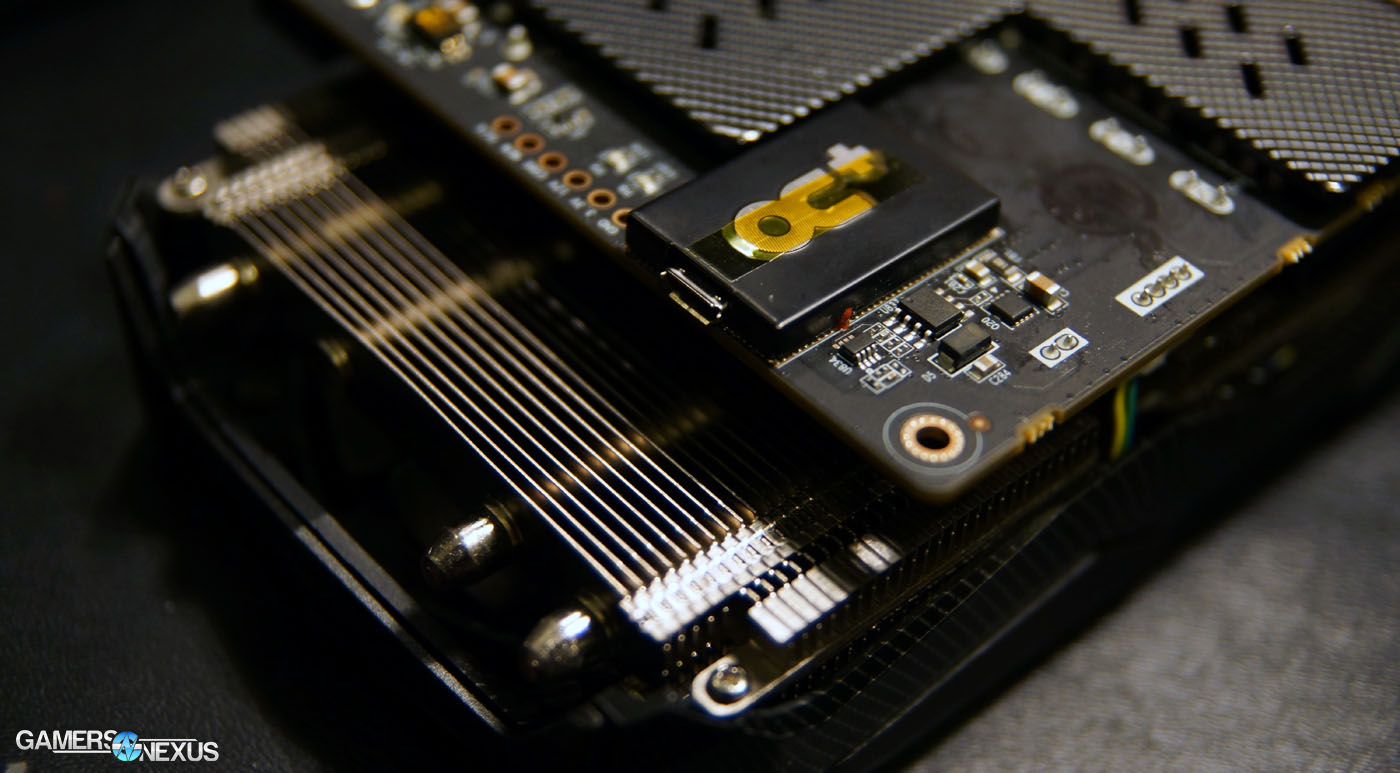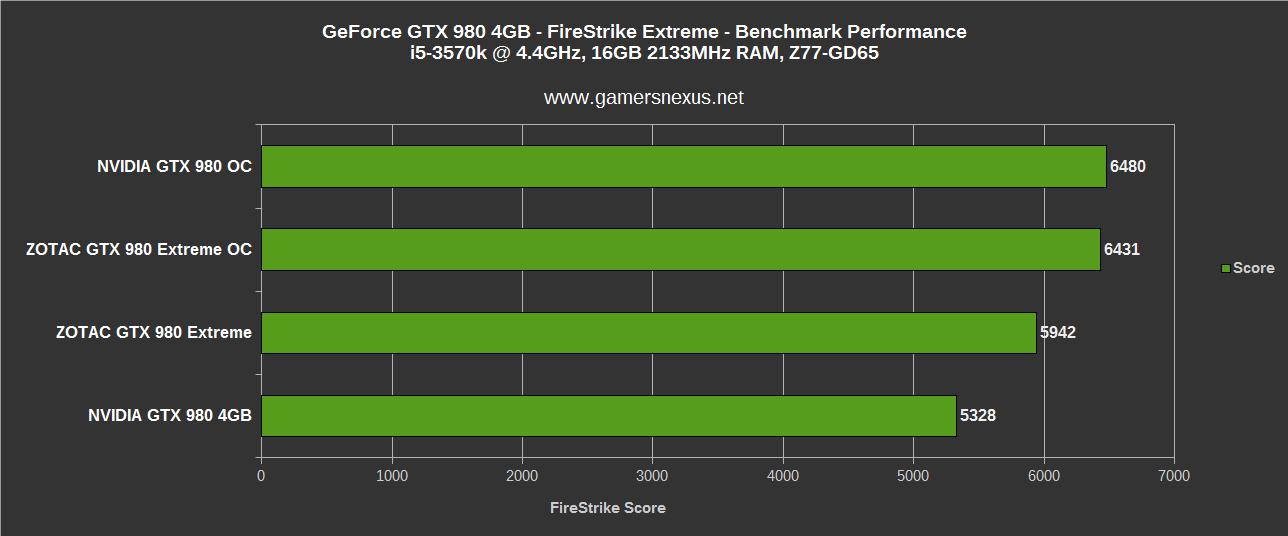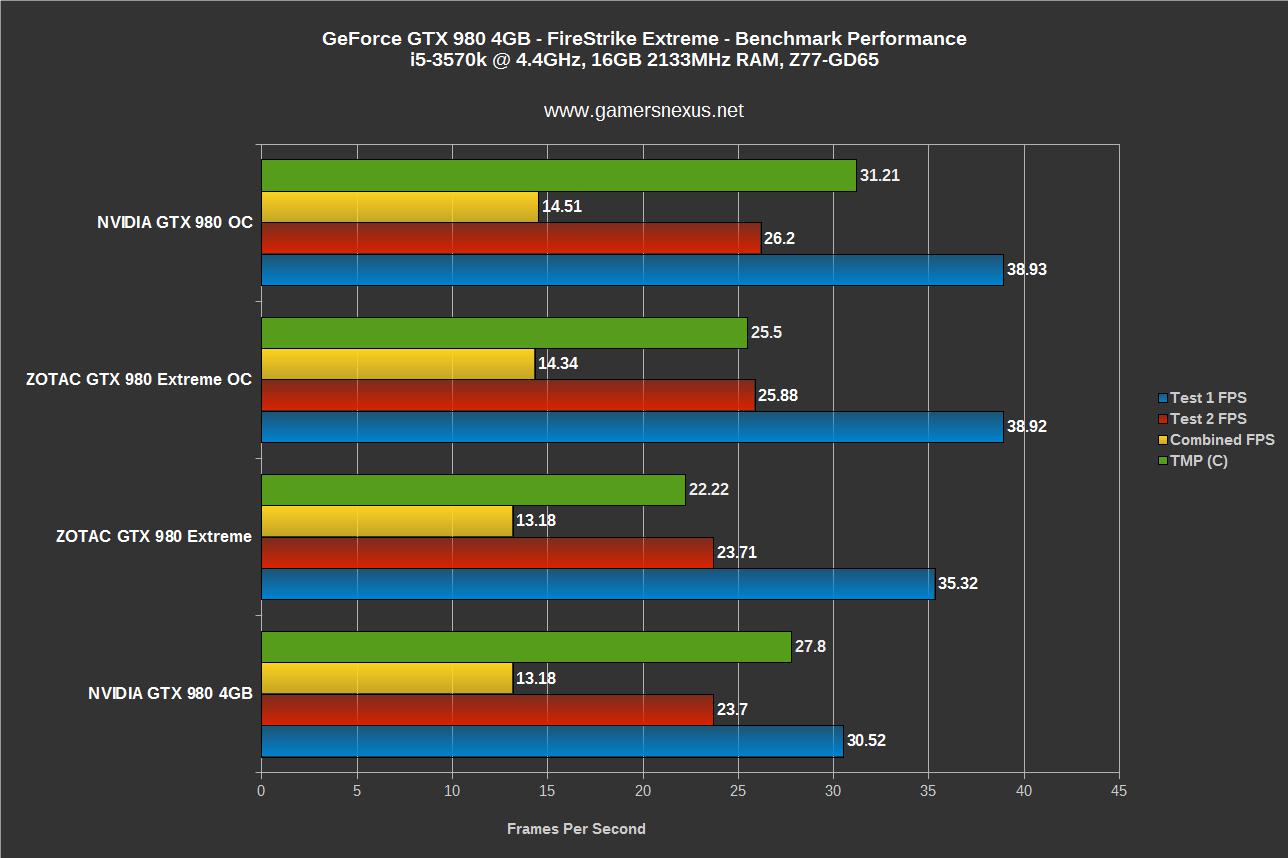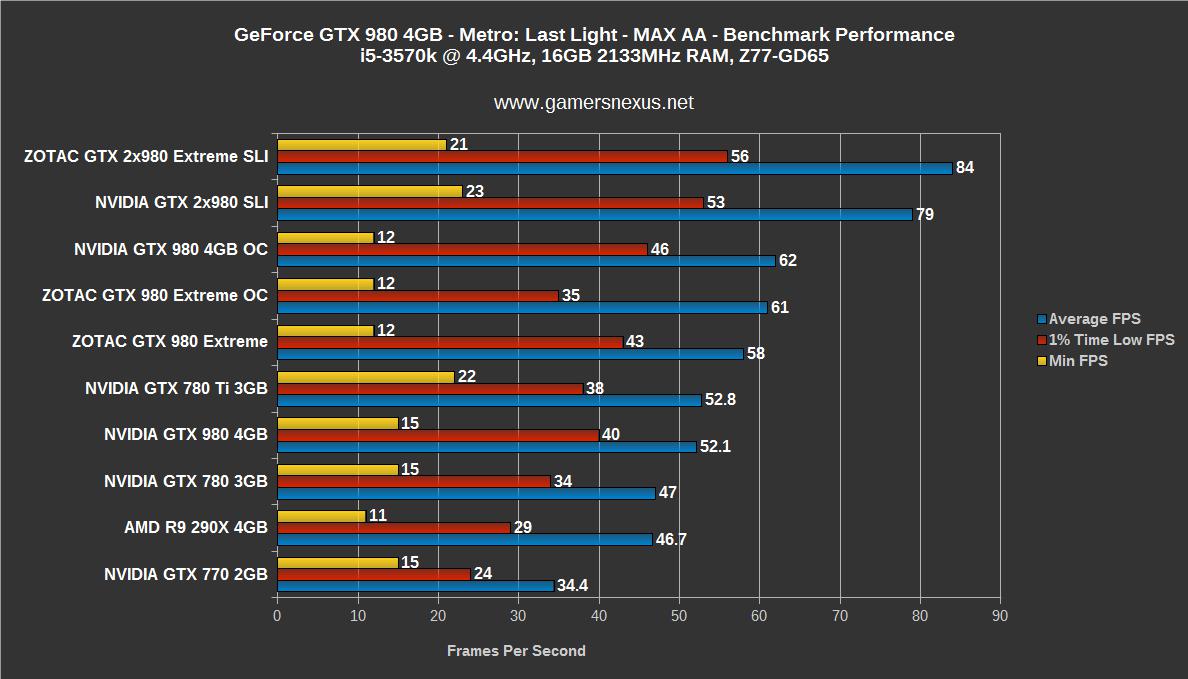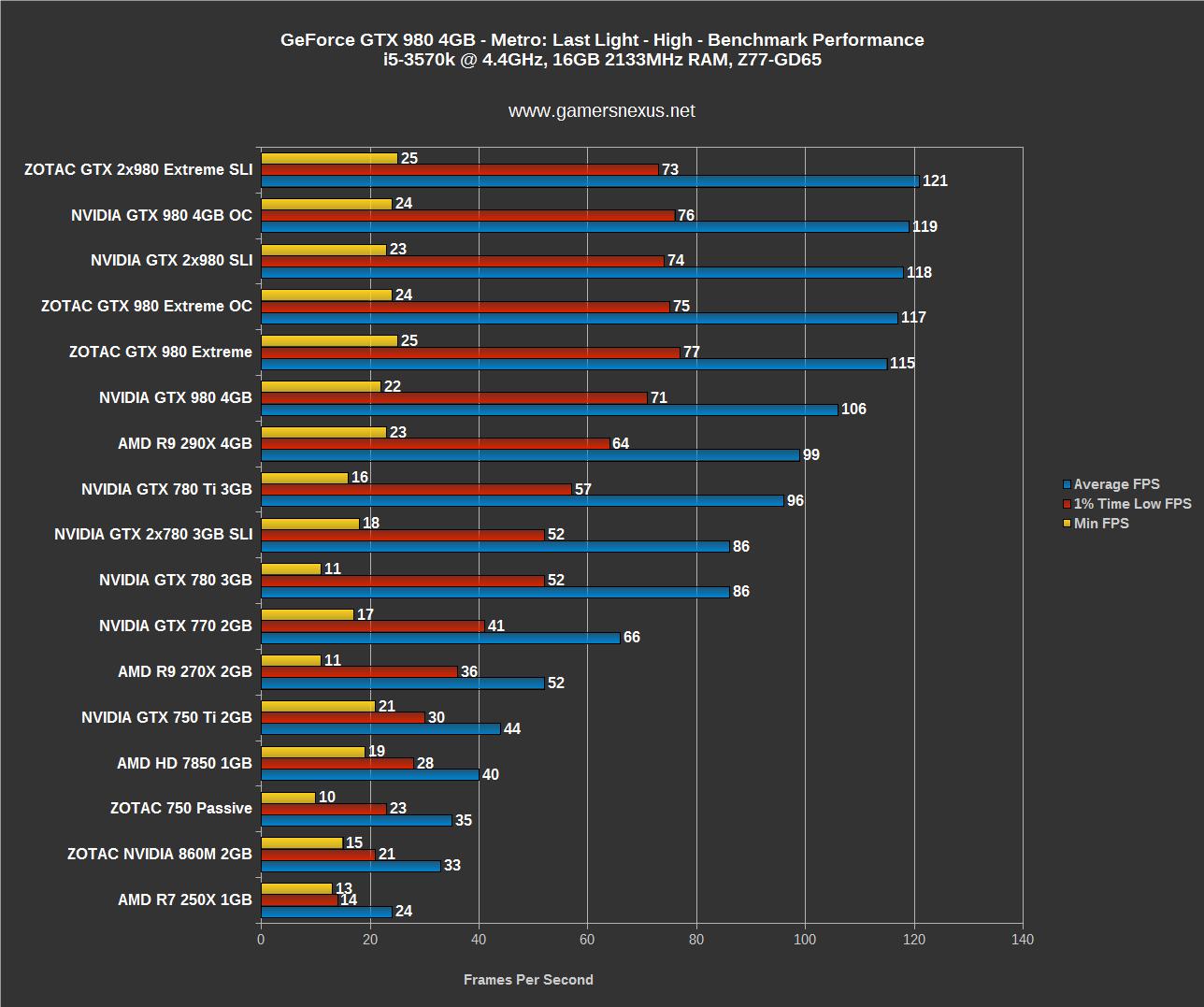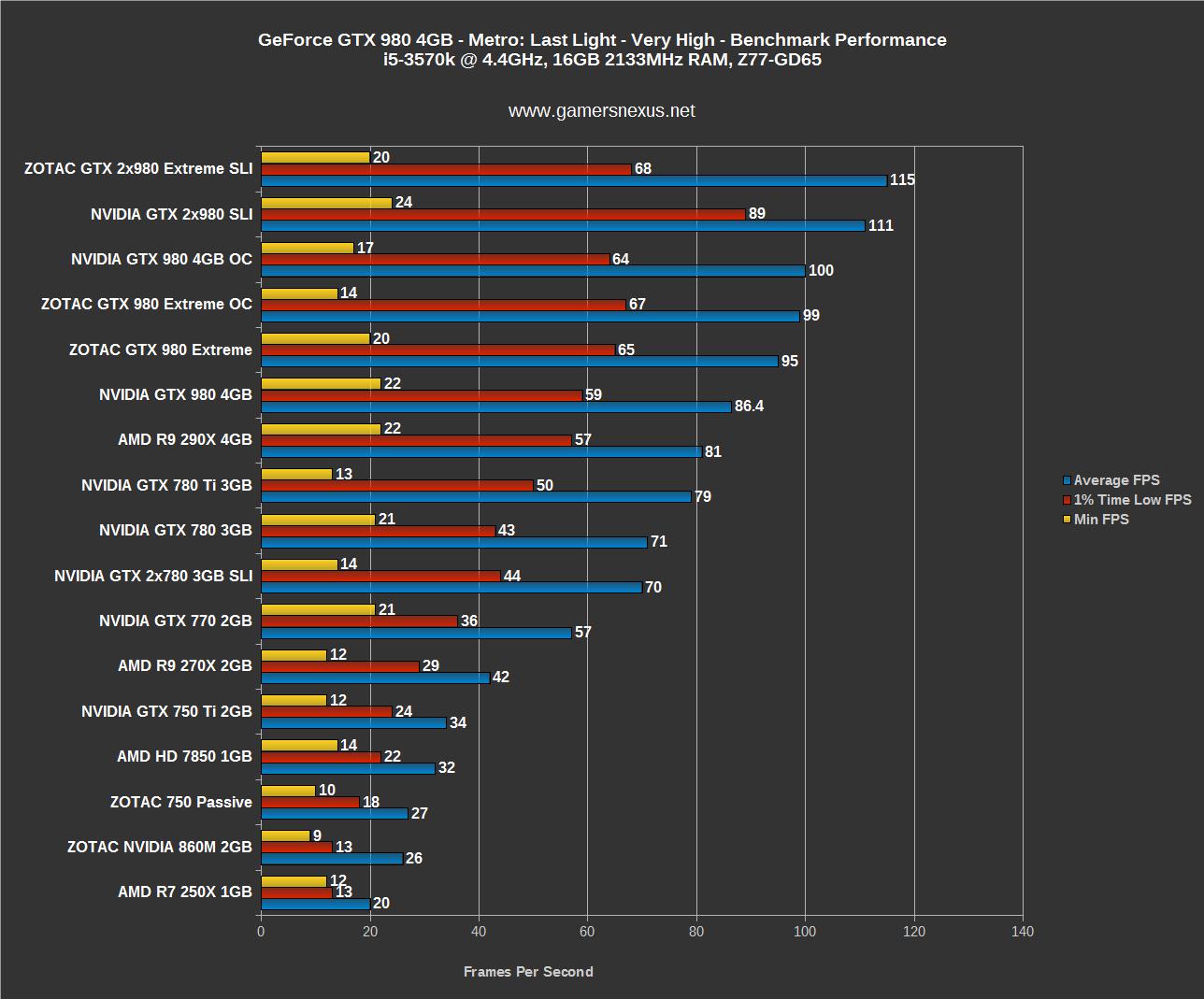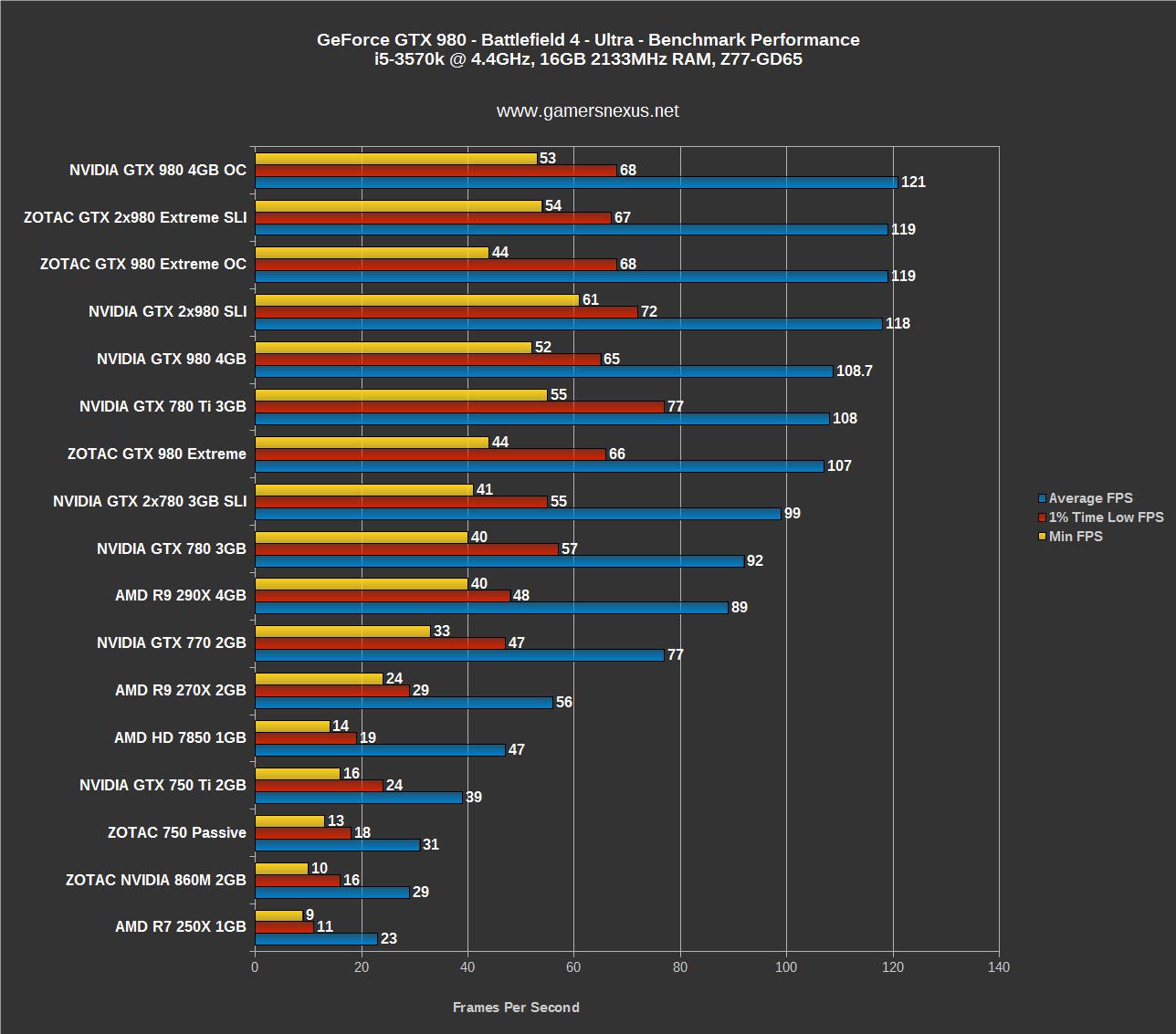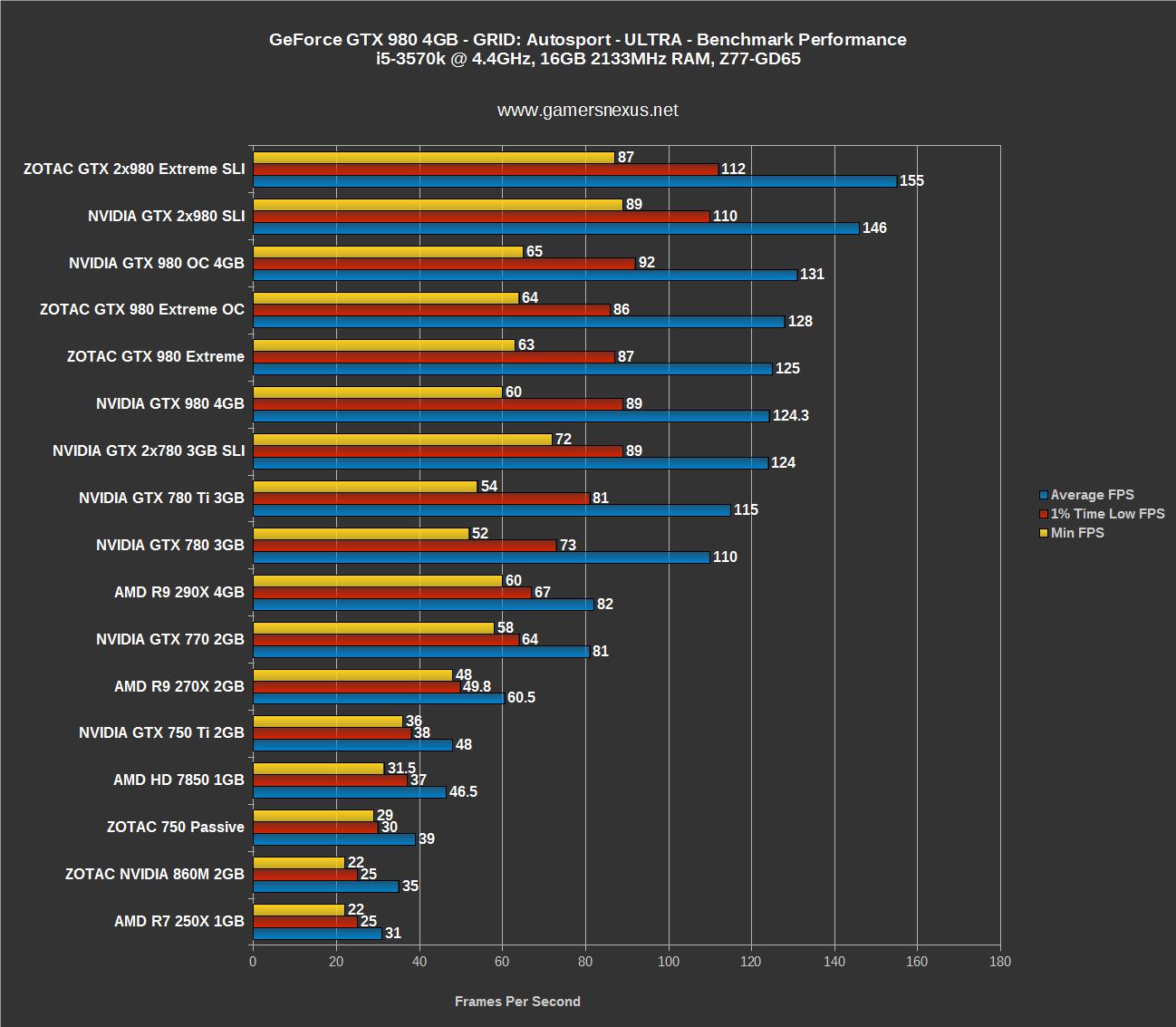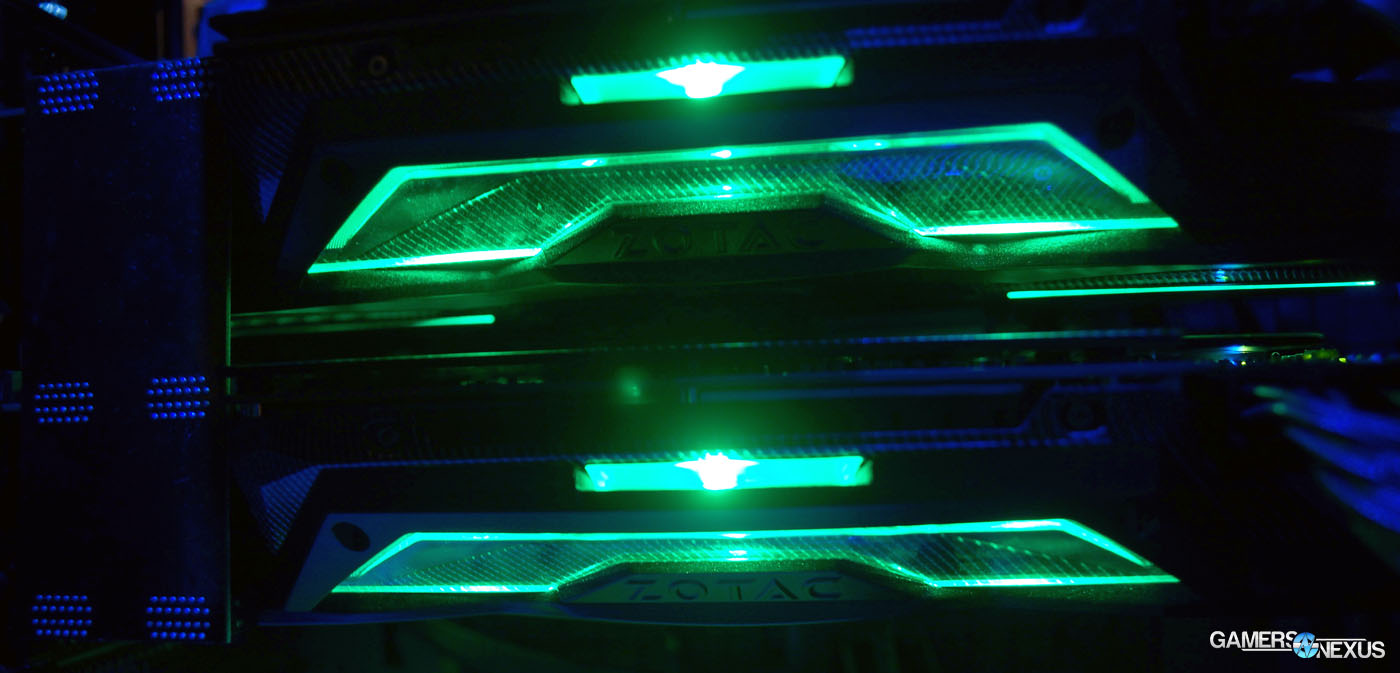Do Not Buy Zotac's GTX 980 Extreme - We Get Higher Overclocks on Reference | Benchmark
Posted on October 21, 2014
The Zotac GTX 980 Extreme ($610) is the most disappointing, saddening attempt at a high-end overclocking device I've ever seen. I've never been so resonantly disheartened by a review product. I've also never seen an aftermarket product perform worse than the reference model while being priced more than 10% higher. The added cost is justified – on paper – by several factors, including a better cooler and higher bin (better GM204).
Testing Zotac's GTX 980 Extreme overclocking card began with excitement and anticipation, rapidly decaying as despair and uncertainty took hold. When the card failed to overclock higher than my reference GTX 980 ($550), I first suspected error on my end – and proved that suspicion wrong – and then went to Zotac with strong emphasis that the BIOS needed a serious overhaul. A BIOS update should have been quick and easy if no hidden problems existed in the hardware, as other video card manufacturers have proven in the past. We published all of this about a week ago, firmly stating that no one buy the GTX 980 Extreme until we could revisit the topic.
We're revisiting it.
But that's jumping the gun. Our introductions are normally a bit more gradual. The GTX 980 Extreme was unveiled to us at Game24, where we filmed our first hands-on with the 970 version of the product. The Extreme is being made in limited quantity and at higher cost to the consumer, specifically with an emphasis on a high overclocking ceiling and a legitimately impressive cooler. Zotac's GTX 980 Extreme was the video card slated to put the company on the map. The cooler, in theory, should be able to handle serious heat and allow for sufficient VRM cooling that high-voltage overclocks should be sustainable, especially with a hand-binned GM204 chip.
“Should.”
The video card also lists an MSRP of $610, matched against the reference GTX 980 (built by nVidia) pricing of $550. The same issues we'll detail herein cascade down the entire Zotac Omega and Extreme lineup, including the 1.212v cap problem. The GTX 970 does not escape Zotac's engineering failures unless purchasing the unmodified reference model built by nVidia.
Zotac GTX 980 Extreme Review, Overclocking, & Benchmark
Zotac GTX 980 Extreme Specs
| GTX 980 Extreme | GTX 980 Reference | |
| Core CLK | 1291MHz | 1126MHz |
| Boost CLK | 1393MHz | 1216MHz |
| Memory Config | 4GB @ 256-bit 7200MHz CLK | 4GB @ 256-bit 7010MHz CLK |
| GPU | GM204 binned higher | GM204 |
| Voltage Limit | 1.212v (theoretically 1.256v - 1.6v if OC+ ever works). | 1.256v |
| MSRP | $610 | $550 |
On paper, the GTX 980 Extreme is an appealing card. The base clock of the device starts us a bit higher than reference – 1291MHz vs. 1126MHz – but the rest of the specs are mostly the same. The memory clock is bumped up to 7200MHz stock, a 190MHz gain over the reference 7010MHz clock.
But a higher base clock doesn't really mean anything. It means that it'll sell better to users who are doing a numbers-vs-numbers comparison between cards on retail sites, I suppose, but that's about it. A lower clock gives more room for overclockers to play and fine-tune, anyway, so it's really unnecessary if purchasing the card with overclocking in mind.
The rest of the specs are in-line with what nVidia's reference lists – except some hidden elements.
Zotac uses a lot of marketing terminology that gets confusing to enumerate. There's IceStorm, FireStorm, OC Plus (OC+), Power Boost, and Exo Armor. Because this doesn't tell you anything useful, here's the break-down:
IceStorm: Zotac's aftermarket cooling solution (see competing ACX, Twin Frozr, etc.). IceStorm uses a triple-fan design, built around a single, central intake fan with two flanking exhaust fans. The exhaust fans ensure that the air is pulled through the heatsink and pushed out of the card to allow more rapid thermal dissipation. Out of all the aspects of the card, this is the one that we were most excited by; the cooler's design is legitimately promising and should allow a high overclock on air, if the rest of the card measured up.
FireStorm: Zotac's custom, very buggy software. Unfortunately, as you'll find out shortly, it's a requirement that overclockers use FireStorm to unlock overvolting properly; in this regard, FireStorm acts like DRM. It has a very “uPlay” feel to it, and not in a good way (is there a good way?).
OC Plus: This is Zotac's version of what you've possibly seen other manufacturers do. Zotac has its own PWM installed to the custom PCB (the root of many problems we'll discuss later). This connects to OC Plus, which is a USB-attached module on the video card that feeds into USB power on the motherboard – the same place you'd connect front panel USB2.0 headers. Without this connected, we lose some control and access to voltage regulation. Note that even with OC Plus connected, voltage is still limited heavily and demands FireStorm for access to what little headroom we have to play.
Power Boost: An up-marketed name for solid capacitors, covered with a metal plate and lettering that aligns upside-down when the video card is mounted in the board.
Exo Armor: This is just a backplate. Unlike the reference design, there is no ability to remove chunks of the backplate to allow better airflow in SLI configurations. The backplate has a nifty carbon fiber look to it, though.
I suppose I'll take a moment to point out Zotac's LED system, too. The card has green (idle) and red (load) LEDs that activate based upon GPU activity and demand. It's unfortunate that the LEDs only light downward and are not user-changeable to different colors, but that's a small gripe when matched to the looming concerns. If nothing else, the LEDs can mercifully be disabled through FireStorm.
Page 2 dives into the backstory of why this card has disappointed us so greatly.
The Story So Far: A Failure to Communicate
My excitement gave way to genuine confusion and concern when I found that I couldn't overclock the GTX 980 Extreme as well as my reference model. The overclock had a low ceiling due to severe voltage limitations.
Breaking into BIOS with Kepler BIOS Tweaker unveils voltage limitations that are a bit frightening, to include a locked 1.212v GPU vCore maximum overvoltage. The reference GTX 980 is capable of 1.256v; that extra headroom is enough to make a world of difference in high overclocks and stability. Note that ASUS' Strix and EVGA's OC units were originally capped at 1.212v also, but neither pushes the extreme OC narrative (or extreme price) that Zotac has advertised.
So we contacted Zotac. This was recapped in the stop-gap article I wrote about this issue. It should be first stated that the company's US PR and marketing team did everything in its power to address my admonishment and insistence that the video card should be better; there's only so much the US team can do before relying upon the overseas team's developers to deliver solutions, though. And even then, there's only so much that team can do before realizing that preliminary engineering has doomed the product from the start.
I told them that BIOS needed an update. Users should be able to at least match the voltage of reference, if not exceed it, I'd insisted. I further argued that the total % TDP of the card (+10% over base TDP) should be increased to allow for additional power as the voltage is increased. This, of course, assumed that the company fixed voltage cap issues, because they'd rapidly run into TDP cap issues. The Zotac card is built to handle the extra power and should be able to cool itself, but there were deeper electrical issues at play; I hadn't realized this yet, though.
We delayed the review by two weeks to allow Zotac the proper chance to deliver updated BIOS. Several follow-up calls and discussions were had, and no matter how many times I reiterated “I really want this card to work – I do. But we need better BIOS,” we never got that.
What I received was an updated version of their already-buggy “FireStorm” software.
The software is allegedly used for overclocking. Anyone who's got a few minutes of GPU overclocking experience will tell you that Afterburner or Precision are both acceptable (even good) tools for overclocking. For the most part, the hardware is software-agnostic. Finer control can be granted in some instances by software, but at the end of the day, we're primarily tweaking voltage and clocks – something that free software does very well.
Up until this point, no software at all would allow a reasonable overvolt above or matching reference. Similarly, FireStorm had failed on several occasions to save profiles (making OC testing a tremendous inconvenience), had misreported clocks, failed to report watt consumption, failed to control fan speed, and even failed so catastrophically as to require a hard reboot. The tool would regularly report successful OCs to insane clocks – like 2GHz (over the ~1393MHz boost CLK base) – even though GPU-z reported stock output.
I couldn't trust the tool.
Still, they sent me an updated version to resolve this voltage issue, so I humored everyone involved.
I immediately noticed something: The updated version of FireStorm allowed me to overvolt the GPU to 1.26v. Jump back to a few paragraphs ago, and you might remember me stating that it was initially locked to 1.212v (1212mV). A software update should not allow extra overhead on voltage; you'd think that if the software were the issue, Precision or Afterburner (we tried both) would have bypassed any FireStorm bugs causing a limitation. After some questioning and thorn-like perseverance, it was determined that OC+ is interacting with FireStorm in a way that resembles DRM (like the iPod requiring iTunes). Striking out against all that overclockers – hackers by nature – stand for, Zotac's components will not overvolt beyond 1.212v when using other software. That'd be fine if FireStorm worked.
It doesn't.
And I gave a preview above as to why, but there's more. FireStorm not only misreports clocks with great unpredictability, it lies regularly about voltage and doesn't even apply the mV OV set by the user. See the below screenshot:
We don't even have voltage readings part of the time, and when we do have them, overvolts do nothing. Literally nothing. It moves a bar on the screen. This is all shown in my video on page 1. Sometimes FireStorm actually does report that voltage increases, but it's impossible to validate that through third-party solutions, according to Zotac. We just have to trust FireStorm.
Right.
Fact-checking with GPU-z only further underlines all of these concerns. In overclocking, as you'll find out below, GPU-z never reported higher than 1.20v even when the FireStorm software exceeded this number (remember: This is the only software we can use to meet 1.26v). We even had a special internal-only version of the tool that allowed up to 1.6v, but that still didn't work. Zotac told us in an email that GPU-z could not be used to accurately measure the voltage output and that we'd have to rely on FireStorm. This lack of GPU-z support is because GPU-z reads from vBIOS, which is locked to 1.212v.
I'd be OK with this revelation if FireStorm lent any confidence in its reporting.
The last two weeks have had enough back-and-forth that trust with the software development team is growing thin, but let's assume it is true: How, as a third-party reviewer, am I supposed to reliably gather reporting metrics that are accurate and trusted without using a third-party utility to check Zotac's work? I wouldn't be so concerned with this if FireStorm actually applied the voltage I asked it to. Or if FireStorm could apply a new voltage after being reset without requiring a software restart. Or if FireStorm would show me voltage at all without requiring a system reboot half the time.
But that's not how it is. FireStorm does not work. It's broken. If Zotac hadn't constrained their hardware with FireStorm to force usage, I could work around it – but alas, we've got to work with what we have given the DRM-like nature of the product.
That still doesn't answer a key question: Why is the voltage limited to 1.212v in vBIOS? Why isn't it at least reference of 1.256v?
We were told by Zotac on several occasions that nVidia imposes a voltage limit on board partners that restricted the 980 Extreme to the voltages we experienced. When I pointed to competing products – Gigabyte's cheaper G1 included – and the reference device, but still received the same answer, I decided to call nVidia. After some fact checking of my own between numerous sources, nVidia, and a personal tear-down of the card, it rapidly became clear that Zotac is using a non-reference VRM and PWM solution. Visual inspection gives this away, though the point is affirmed by all of the voltage testing we performed; marketing gimmickry and OC+ made discovery of deeper issues difficult.
Based strictly on my own tear-down and voltage testing of the card, it appears that the VRM is weaker than the reference solution. It is our pure speculation that Zotac cut corners to either rush the device to market (ahead of spec) or lower costs of production, potentially complicated by the custom PCB built for the Extreme (which sees use in other models, too).
When pressed on the low voltage, Zotac's PM team told us that they were trying to limit RMAs (warranty fulfillment) by locking voltage; then they told us that their software would unlock the voltage with OC Plus, which immediately invalidated the previous statement. Think about that cognitive dissonance: We're limiting warranties by restricting voltage unless you use our software that you're forced and encouraged to use, in which case you can overvolt it higher.
Smells like a last-minute defense against mounting pressure.
The PMs continued to blow smoke, stating that their video card holds some of the highest overclocks in the region. When pressed for proof – settings that I could replicate – I was given a cropped screenshot showing only the voltage and memory clock, nothing else. No core clock, no % TDP, no proof that this was even applied (one can screenshot any setting before application) or that a GTX 980 Extreme was used.
I had difficulty determining what was going on behind the scenes: Either Zotac has grossly incompetent engineers and product managers, was lying to me, is deeply embarrassed, jumped the gun and is now paying for it, or a mix of all these options.
I'm not sure I'd want to buy a video card from a company that acts like this when faced with criticism from a reviewer. Let me be clear: When we find an issue with a product we're testing, we always raise concern with the manufacturer first to determine if it can be resolved. A BIOS update should have been resolvable, but after gaslighting me for 1-2 weeks, it became clear that Zotac either lacked the interest or the ability to do so – or there are deep electrical issues with the 980 Extreme.
The sad thing is that we haven't even gotten to the other concerns yet, like the tremendous size of the GTX 980 Extreme, which effectively consumes 2.5 expansion slots internally. This makes SLI a bit tight and eliminates other expansion options, depending on how close your PCI-e slots are on the board.
It certainly doesn't overclock, though, and that's really all we need to know. Let's dig into exactly why this thing is worse than reference on the next page, where benchmarking is performed.
Test Methodology
Each device was tested using the latest AMD and nVidia drivers (344.16). Overclocking was gradually stepped-up and tested for stability between each major increment, using FireStrike Extreme on loop for stability testing. FireStrike Extreme was also used for more strenuous OC benchmarking. We ended up skipping SLI overclock performance testing with the 980 Extreme due to all the other concerns and the tremendous time invested up until this point.
Our standard test methodology applies here. For thermal benchmarking, we deployed FurMark (issues exhibited with boost CLK) & FireStrike Extreme to place the GPU under load while logging thermals with HW Monitor+ and GPU-z. FurMark executed its included 1080p burn-in test for this synthetic thermal benchmarking. In FPS and game benchmark performance testing, we used the following titles:
FRAPS was used to log frametime and framerate performance during a 120 second session. FRAFS was used for analysis. Tests were conducted three times for parity. GPU-z logged boost clocks, checked the ASIC quality, and extracted BIOS; Kepler BIOS Tweaker analyzed BIOS for limitations.
NVidia 344.16 drivers were used for all tests conducted on nVidia's GPUs.
| GN Test Bench 2013 | Name | Courtesy Of | Cost |
| Video Card | (This is what we're testing). | NVIDIA, ZOTAC. | $550, $610. |
| CPU | Intel i5-3570k CPU Intel i7-4770K CPU (alternative bench). | GamersNexus CyberPower | ~$220 |
| Memory | 16GB Kingston HyperX Genesis 10th Anniv. @ 2400MHz | Kingston Tech. | ~$117 |
| Motherboard | MSI Z77A-GD65 OC Board | GamersNexus | ~$160 |
| Power Supply | NZXT HALE90 V2 | NZXT | Pending |
| SSD | Kingston 240GB HyperX 3K SSD | Kingston Tech. | ~$205 |
| Optical Drive | ASUS Optical Drive | GamersNexus | ~$20 |
| Case | Phantom 820 | NZXT | ~$130 |
| CPU Cooler | Thermaltake Frio Advanced | Thermaltake | ~$65 |
The system was kept in a constant thermal environment (21C - 22C at all times) while under test. 4x4GB memory modules were kept overclocked at 2133MHz. All case fans were set to 100% speed and automated fan control settings were disabled for purposes of test consistency and thermal stability.
A 120Hz display was connected for purposes of ensuring frame throttles were a non-issue. The native resolution of the display is 1920x1080. V-Sync was completely disabled for this test.
The video cards tested include:
- AMD Radeon R9 290X 4GB (provided by CyberPower).
- AMD Radeon R9 270X 2GB (we're using reference; provided by AMD).
- AMD Radeon HD 7850 1GB (bought by GamersNexus).
- AMD Radeon R7 250X 1GB (equivalent to HD 7770; provided by AMD).
- NVidia GTX 780 Ti 3GB (provided by nVidia).
- NVidia GTX 780 3GB x 2 (provided by ZOTAC).
- NVidia GTX 770 2GB (we're using reference; provided by nVidia).
- NVidia GTX 750 Ti Superclocked 2GB (provided by nVidia).
Overclocking Maxwell – The GTX 980 Extreme
Overclocking Maxwell is a bit different from the experience with Kepler. Without diving into deeper hardmods or LN2 overclocking, most users will be pretty happy playing around with the TDP % (extra power over TDP), clock frequency offset, memory frequency offset, and GPU vCore. Some software offers memory voltage offset, which can be useful for more extreme overclocks.
With Maxwell and Boost 2.0 (you can disable Boost 2.0), the clock will modulate based upon thermal and power concerns and demand. If the video card is unable to allocate more power for a higher voltage (V=IR), the overclock will fail and/or the GPU will downclock. Increasing the power target % from 100% to 125% gives us an extra 25% more power (headroom) to play with overclocking.
Increasing the clock and increasing the voltage will both consume power, so at some point, it becomes necessary to increase the power target percentage in order to sustain both a high clock and overvoltage. It is generally advisable to increase the clock as high as possible without touching voltage so that the power can be “saved” for the clock itself, rather than spent on the voltage increases. Overvolting the GPU improves stability for high clockrates and eventually becomes necessary.
The reference maximum TDP of nVidia's design is 225W (2x6-pin power connectors), with base TDP at 165W. Our reference cards are capable of 125% power. Zotac's GTX 980 Extreme PCB is rated for a max TDP of 390W stock (according to the company) with an alleged nVidia max TDP of 435W after +11% TDP target. The card can push 111% power, so 435/390 = 1.11. This extra power should theoretically give us more room to overclock because a higher voltage is sustainable before we run out of wattage.
Unfortunately, we need more than that – like a good VRM and functional OC interfacing.
OC Performance – GTX 980 Extreme vs. GTX 980 Reference
Here's a table of the clocks I was able to achieve on each device (and the stability between tests):
GTX 980 Reference OC Attempts
| GTX 980 Reference | |||||||||||
| STABLE? | CLOCK | OUTPUT CLK | MAX LOGGED | MEM | PWR | OV | AVG TMP | AVG FPS 1 | AVG FPS 2 | AVG FPS CB | SCORE |
| Y | 230 | 1445 | 1482.5 | 211 | 23% | 12mV | 22.23C | 37.54 | 25.28 | 13.87 | 6273 |
| Y | 250 | 1465 | 1490.3 | 211 | 23% | 12mV | 24.4C | 37.76 | 25.46 | 13.97 | 6311 |
| Y | 275 | 1490 | 1515.6 | 250 | 23% | 12mV | 26.17C | 37.88 | 25.76 | 14.31 | 6381 |
| N Driver Crash | 300 | 1515 | N/A | 400 | 23% | 12mV | N/A | N/A | N/A | N/A | N/A |
| N Flickering | 300 | 1515 | N/A | 400 | 23% | 18mV | N/A | N/A | N/A | N/A | N/A |
| N Driver Crash | 300 | 1515 | N/A | 400 | 23% | 24mV | N/A | N/A | N/A | N/A | N/A |
| Y | 285 | 1500 | 1537.7 | 300 | 25% | 18mV | 31.47C | 38.53 | 25.88 | 14.32 | 6418 |
| Y | 295 | 1510 | 1560.3 | 325 | 25% | 38mV | 31.21C | 38.93 | 26.2 | 14.51 | 6480 |
ZOTAC GTX 980 Extreme OC Attempts
| 980 Extreme 1 | |||||||||||
| STABLE? | CLOCK | OUTPUT CLK | MAX LOGGED | MEM | PWR | OV | AVG TMP | AVG FPS 1 | AVG FPS 2 | AVG FPS CB | SCORE |
| Y | 108 | 1500 | 1525.9 | 300 | 11% | 0 | 47.5 | 38.92 | 25.88 | 14.34 | 6431 |
| N System Crash | 115 | 1507 | N/A | 325 | 11% | 0 | N/A | N/A | N/A | N/A | N/A |
| N Driver Crash | 115 | 1507 | N/A | 325 | 11% | 6mV | N/A | N/A | N/A | N/A | N/A |
| N Driver Crash | 112 | 1505 | N/A | 300 | 11% | 6mV | N/A | N/A | N/A | N/A | N/A |
| N System Crash | 112 | 1505 | N/A | 300 | 11% | 12mV | N/A | N/A | N/A | N/A | N/A |
| N Driver Crash | 112 | 1505 | N/A | 325 | 11% | 18mV | N/A | N/A | N/A | N/A | N/A |
| N Flickering | 112 | 1505 | N/A | 325 | 11% | 24mV | N/A | N/A | N/A | N/A | N/A |
I was able to push my reference GTX 980 up +295MHz, resulting in a boost clock of 1560.3MHz. We didn't play with the memory clock much beyond 325MHz, though other outlets have reported +800MHz overclocks with decent regularity. Our focus was on the core / boost clock. This 1560.3MHz boost OC was achieved with 125% power, a 38mV OC (stability in endurance testing), and with an operating temperature of 35.21C (dT over ambient).
The performance output of this OC, when tested in FireStrike Extreme, was rated with a score of 6480. FPS results are shown in the ensuing charts.
Zotac's GTX 980 Extreme, on the other hand, could not exceed a +108MHz OC (over a higher base, mind you) at 111% power with a 325MHz memory OC. The result was a 1525.9MHz boost clock, a full 34.4MHz lower than reference. We were able to sustain this with a 6mV overvoltage, but unfortunately could not push anything beyond this point. The OV was applied using other software when FireStorm seemed to exhibit issues. Pushing even a single digit beyond this point resulted in flickering, tearing, and driver failures.
Even if this has a small impact on in-game FPS, the bottom line is clear: If you want to overclock, buy something better. Anything. The G1, the Strix, MSI's offerings – any of them. Even reference is better, though sustaining our high OC (above) won't be good for the longevity of the GPU. Paying an extra $60 for a worse OC just does not make sense. I am further scared away from the Extreme after observing how the company responds to criticism.
Explaining why Overvolting Fails
Here's the problem: The GTX 980 Extreme can only go to 1.20v through software due to a vBIOS limitation that is set (and could be changed) by ZOTAC. The company has failed to make any changes, instead constantly pushing us toward a software solution -- a very buggy one. Because Precision and Afterburner don't understand OC+ and cannot bypass the hard-set vBIOS limitation of 1.20v (or 1.212v, depending how you measure it), we're forced to rely upon FireStorm. Theoretically, FireStorm would utilize OC+ to bypass the vBIOS limitation (so GPU-z will still report 1.20v, but a multimeter could read-out as 1.26v or higher). This theory falls to pieces when realizing that FireStorm has sporadic success and seems wildly unpredictable and unstable, depending on configuration.
Zotac GTX 980 Extreme Benchmark vs. Reference GTX 980
The charts really do the talking here. Sure, the stock 980 Extreme is better out-of-box than the reference 980, but that doesn't mean anything. All that means is that the 980 Extreme ships with a higher base clock, something immediately invalidated by a few-second overclock on the reference 980 to match the OC. The OC'd 980 reference outperforms the 980 Extreme everywhere.
We didn't bother overclocking for SLI testing; the gains will be linear from single GPU testing, more or less.
Thermal dissipation was the only positive for Zotac's Extreme cooler, shown in the charts. That's still not worth $610 when the G1 can be had for $630, the Strix for $580, and so forth.
Conclusion: Do Not Buy This Video Card
The GTX 980 Extreme should be kept locked away until its creators can correct the errors made. Zotac jumped the gun and they shouldn't have; something got botched in design and development, and now they're either too incompetent or too embarrassed to acknowledge the issues.
Do not buy the GTX 980 Extreme. Maybe if they fix BIOS and there aren't deeper, unresolvable hardware issues – but I'm not sure if that'll happen at this point.
ASUS' GTX 980 Strix ($580) is cheaper and will accomplish very similar gains to the 980 Extreme. Gigabyte's G1 980 ($630) can push high TDP and much higher voltages, meaning a properly extreme overclock is feasible. You'd probably want to mod it with liquid for something that high, though. It'll destroy the 980 Extreme at every turn and is all of $20 more. Reference is also a wiser buy for most users, priced at $550 (if it's ever back in stock) and with a clean aesthetic.
I can't help but feel let down by Zotac. There was big talk – everything about the design backed it up, from what we saw – and then it failed. Not only did it fail, but the PM team failed to listen to criticism while they had the chance. That window has expired. The 980 Extreme should have put Zotac on the map, but they'll instead be lucky if this misstep doesn't cause sweeping damage to the company's reputation.
It's really a shame. The whole thing is somewhat sad – such promise squandered by a cheap VRM, an attempt at forcing software usage, and an awfully closed-minded PM team that refused to listen to professional reviewers when given the chance.
Maybe next time.
- Steve "Lelldorianx" Burke.
